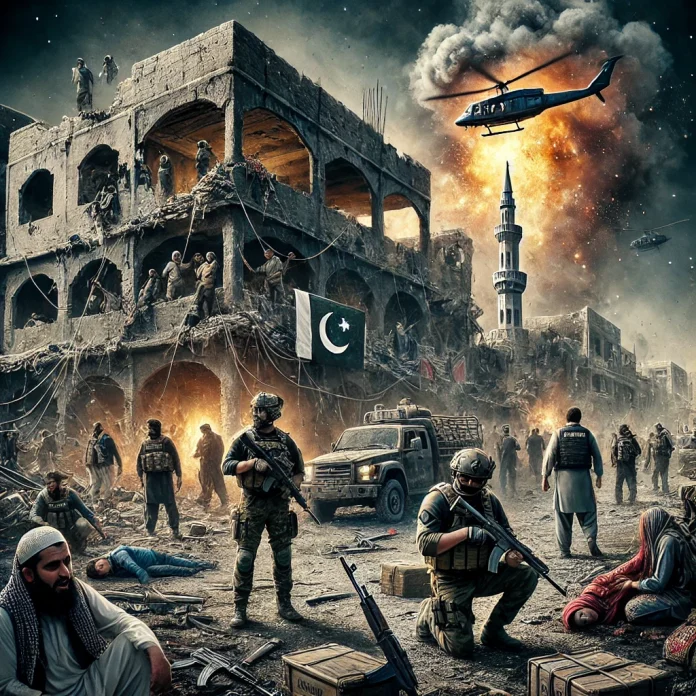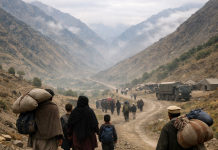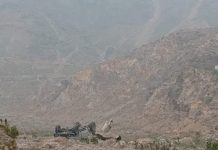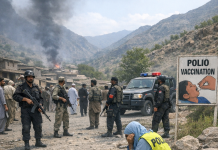By Ashrafuddin Pirzada
On the evening of March 15, 2025, a powerful blast shook the Urmarr locality of Peshawar, marking the violent end of Mufti Munir Shakir, the cleric who founded Lashkar-e-Islam (LI)—one of Pakistan’s most feared militant groups. His death in an improvised explosive device (IED) blast closed a chapter in Khyber’s history, a region deeply affected by his radical ideology and militant activities.
Shakir was critically injured when an IED detonated near his seminary, Jamia Masjid Nida-e-Quran. The explosion was so intense that he was rushed to Lady Reading Hospital, where he succumbed to his injuries. No group has claimed responsibility for the attack. Still, given his long history of militant involvement and numerous enemies, speculation suggests it could have been a revenge killing or an internal dispute within militant factions.
A Surge in Terrorism: Pakistan Under Attack
Pakistan is once again witnessing a sharp rise in terrorist attacks, particularly in Khyber Pakhtunkhwa and Balochistan. The country is now ranked the second most terrorism-affected nation in the world, according to the Global Terrorism Index (GTI) 2025. The frequency and intensity of these attacks highlight the growing security challenges.
Jafar Express Attack and Hostage Rescue
On March 11, 2025, terrorists attacked and hijacked the Jafar Express near Sibi, taking multiple hostages. The train, carrying around 400 passengers from Quetta to Peshawar, was ambushed in the rugged Bolan Pass region.
The Pakistan Army, Air Force, Frontier Corps (FC), and Special Services Group (SSG) launched a joint operation in response. ISPR Director General Lt. Gen Ahmed Sharif stated that the terrorists were coordinating with their handlers in Afghanistan via satellite phones. The rescue mission was complex as the hostages were held in small groups, each guarded by suicide bombers. Snipers eliminated the bombers, allowing the captives to escape. Despite the operation’s success, 21 civilian passengers and four FC personnel lost their lives.
Terrorists Armed with Foreign Weapons
One of the most alarming aspects of the recent attacks is the discovery of advanced foreign-made weapons in terrorist hideouts. Security forces have repeatedly seized M4 Carbines, M16A4 rifles, and anti-personnel grenades—weapons previously supplied by the United States to Afghan security forces before the U.S. withdrawal in August 2021.
These weapons have fallen into the hands of Tehreek-e-Taliban Pakistan (TTP) and other militant groups, raising concerns about the Afghan Taliban’s role in preventing cross-border militancy. Pakistan has accused Kabul of harboring TTP militants, but the Afghan interim government denies these allegations.
Major Operations Against Militants
In recent months, Pakistani forces have launched multiple operations to combat terrorism:
March 4, 2025: A TTP attack on Bannu Cantonment was repelled, with 16 terrorists killed, including four suicide bombers.
February 28, 2025: An intelligence-based operation in North Waziristan led to the elimination of six militants and the recovery of M24 sniper rifles and M16A4 rifles.
February 15, 2025: Clashes in Khyber Pakhtunkhwa resulted in 15 militant deaths.
February 1, 2025: In Harnai, Balochistan, security forces killed 11 terrorists and destroyed several hideouts.
These incidents highlight how militants, armed with sophisticated weaponry, have intensified their attacks, challenging Pakistan’s security forces.
The Silencing of Journalists and Civil Society
While security forces face direct attacks, journalists, human rights activists, and social workers have also become prime targets. Those reporting on militancy, extremism, and cross-border violence face harassment, censorship, and assassination.
The murder of journalists has become alarmingly frequent:
June 19, 2024: Khalil Jibran Afridi, former president of the Landikotal Press Club, was shot dead near his home.January 2025: Senior journalist Zafar Iqbal was assassinated in North Waziristan, a region where reporters live in constant fear.
In the Khyber district, at least five journalists have been killed in the past two years, forcing many to flee or quit journalism.
Qazi Fazlullah, a veteran journalist and former president of the Tribal Union of Journalists, describes the situation as unprecedented. “It is nearly impossible for journalists in the tribal areas to report freely. Those who expose militancy or security operations either disappear or end up dead.”
Human rights activists and social workers face a similar fate. Those advocating for women’s rights, education, and counter-extremism initiatives are either forced into silence or exile.
The Human and Economic Cost of Terrorism
Civilians remain the biggest victims of terrorism. In 2024 alone, over 1,000 civilians were killed, while 250 security personnel lost their lives. Khyber Pakhtunkhwa, Balochistan, and parts of Sindh remain the worst-hit areas.
Displacement and Psychological Trauma
Entire families have been forced to flee their homes due to military operations and militant violence, leading to a humanitarian crisis. Children in conflict zones are particularly vulnerable, with many developing post-traumatic stress disorder (PTSD). Schools remain closed, businesses have shut down, and entire communities are caught in a cycle of fear and violence.
Economic Devastation
Pakistan has suffered economic losses exceeding $150 billion due to terrorism over the past two decades. Key industries such as tourism, foreign investment, and local businesses have been severely affected. Investors hesitate to engage in conflict-prone areas, further crippling economic recovery.
Wali Khan Shinwari, a journalist and educationist who has been living abroad for some time, warns of the long-term consequences. “Our younger generation is growing up in a war-like environment where schools are bombed, and job opportunities are nonexistent.”
A Path Forward: Beyond Military Operations
Pakistan’s fight against terrorism requires more than just military action. A multi-pronged approach is essential:
Strengthening Border Security
Enhancing surveillance with drones and radar systems and reinforcing the Pak-Afghan border fencing to prevent militant infiltration.
Closer collaboration between ISI, Military Intelligence, and civilian agencies is the need of the day.
Utilizing AI-based intelligence gathering to track terrorist movements along with diplomatic Efforts with Afghanistan must be intact.
The government must put pressure on the Afghan Taliban to take action against TTP sanctuaries in Afghanistan and engage regional powers like China, Russia, and Turkey for mediation.
Counter-Radicalization and Development
Expanding education and job opportunities in conflict zones.
Launching media campaigns to counter extremist propaganda.
Protecting Journalists and Civil Society.Implementing strict laws to ensure the safety of journalists and activists.Encouraging independent reporting to expose both militant and state abuses.
A Nation at a Crossroads
Pakistan stands at a critical juncture. The rise in cross-border militancy, the proliferation of foreign weapons, and the silencing of journalists demand urgent and comprehensive action.
This is not just a battle for security forces—it is a national struggle requiring the combined efforts of the government, civil society, media, and the public. Only by addressing the root causes of extremism can Pakistan hope to achieve lasting peace and stability.










